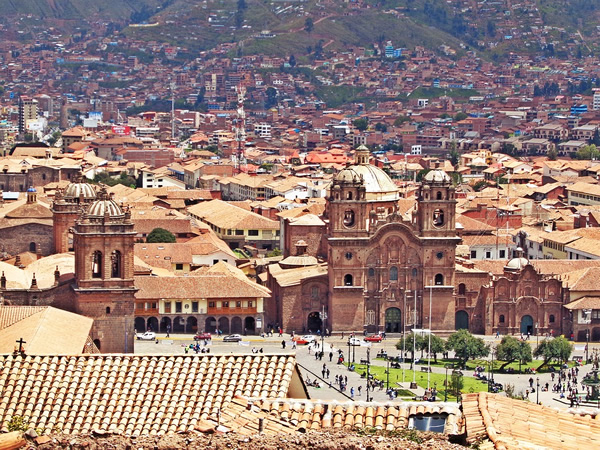Spanish Language Learning and Cultural Immersion in Cusco, Peru
By Carrie Peterson
|

|
|
Skyline of Cusco, Peru. A great place to learn Spanish and experience cultural immersion.
|
El Mercado San Pedro hums with humanity wandering through dirt aisles on a Wednesday afternoon. My young Peruvian teacher treats me to a glass of fruit juice, thick like a milk shake, and we sit
on stools in front of the juice stand sipping slowly and reading the newspaper together. Later we walk through the market, packed with traditional clothes, shoes, soup stands, flowers, dried llama fetuses, hunks of stinking fresh meat, live
frogs being methodically peeled by an old woman with black fingernails, aisles of fresh fruit and bread. She talks to me in Spanish, I answer her questions clumsily, and we wander through the entire market before returning to the school where
I am taking Spanish immersion courses. Initially I intended to spend only one week studying Spanish intensively in Cusco, Peru, then do some volunteer work, travel in South America, and be back home in two months. However, the first week of
classes was so enjoyable and challenging that I became enamored with the idea of becoming at least semi-fluent, and (luckily having no other pressing obligations) decided to extend my stay to six months.
Learning Spanish Through Immersion is the Best Way to Go
Learning a foreign language by immersion is truly the only way to go, especially if you don’t relish the idea of spending semesters at a local university struggling with grammar, want to experience another culture,
and have a few months to spare. The motivation to learn is very high during immersion, since day-to-day chores and friendships depend on it.
The way I chose my language school was by first deciding that I wanted to study in Peru (out of a fascination for the history and culture as well as it being one of the better countries in Latin America to learn Spanish
because of the lack of significant accent and use of more common expressions), then researching schools on the Web and corresponding with owners and previous students. Another method, for those inclined to be more spontaneous, is to visit schools
after you arrive in your city of choice. This gives you a clear idea of what the school is actually like, since anyone can make a good website.
After nearly two months of research and correspondence,
I decided on Wiracocha Spanish Language School. This school proved to
be very flexible and willing to cater to individual tastes, while at the same time being professional. Classes can be one-on-one or in groups of two or three, from two to eight hours a day Monday through Friday (with a different teacher for each
2-hour class). Be careful not to be too ambitious about the number of class hours you schedule per day, as it is easy to get burned out. Six hours a day was plenty.
While most of the classes are spent in classrooms learning grammar or practicing conversation, there are also frequent diversions with movies in Spanish, songs, and field trips to various museums, plazas, markets, or the
zoo. Wiracocha arranges your (free) pick-up at the airport, homestays, tourist activities, and various volunteer work or internships, if you desire. Tuition varies according to how many hours of class you are taking, but for four hours per day and a homestay, the total comes to about $300 per week.
A mixed blessing at Wiracocha is that the teachers are subject to change every week. The benefit is that each teacher will assess you separately and notice different gaps in your knowledge. The different teaching styles
can also be helpful, and you can generally request a teacher if you have a favorite. I recommend having at least one teacher stick with you the whole time to monitor your progress and communicate with other teachers about what you have been doing.
Enjoying the Culture and Food in Cusco
Some of the benefits of immersion language learning come as a surprise. For instance, I did not expect to love Peruvian food as much as I do, but living with a local family gave me the chance to taste and even learn how
to cook some of the delicious soups, rice, and quinua (a cereal grown in Cusco since Inca-times) dishes. I participated in salsa dance classes (which are offered free every night at several clubs in the city center), and they became a way for
me to relax and let my brain switch gears after a day of classes and studying. Living in one place for several months enabled me to get to know locals and glean insights into Cuscanean culture that can’t be found in guidebooks. My family
also offered me the unique experience of joining their folk dance group for a performance during one of the many festivals in Cusco. All of these activities contributed invaluably to the language learning process.
Carrie Peterson studied Spanish in Peru.
|
